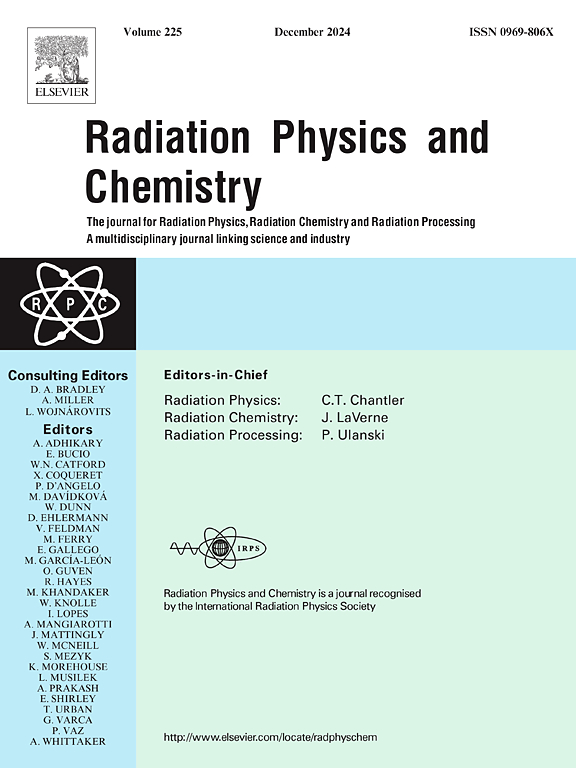磁性氧化铁纳米颗粒的辐射分解合成:前驱体浓度、pH、聚合物浓度和聚合物分子质量控制的重要性研究
IF 2.8
3区 物理与天体物理
Q3 CHEMISTRY, PHYSICAL
引用次数: 0
摘要
本研究考察了影响铁氧化物辐射分解合成的参数,即前驱体浓度、pH、聚合物类型、浓度和分子量对γ辐照Fe(III)前驱体悬浮液中Fe2+生成的影响。结果表明,Fe3+浓度的降低增强了还原程度,在低至10 kGy的剂量下可实现100%的Fe3+转化率。聚合物浓度和分子量显著影响Fe(III)前驱体的稳定性、还原程度以及合成的纳米颗粒的相组成和形貌。在低聚合物浓度(0.185%)下,前驱体颗粒不稳定,形成大的聚集体,而高聚合物浓度(10%)阻碍了还原种与前驱体颗粒的相互作用;在这两种情况下,还原程度都低于中间聚合物浓度(1.85%)。高分子量的右旋糖酐(40000和500000 Da)具有更好的稳定性,而低分子量的聚合物(6000 Da)不能稳定前驱体纳米颗粒,证实了前驱体纳米颗粒具有空间稳定作用。与电子和异丙醇自由基的作用相比,放射性分解产生的聚合物自由基在还原中的作用较小。这项工作强调了精确控制合成参数的重要性,以便通过辐射分解方法获得定义良好的氧化铁纳米颗粒。本文章由计算机程序翻译,如有差异,请以英文原文为准。
Radiolytic synthesis of magnetic iron oxide nanoparticles: A study on the importance of controlling precursor concentration, pH, polymer concentration and polymer molecular mass
In this study parameters influencing the radiolytic synthesis of iron oxides, namely the effect of precursor concentration, pH, polymer type, concentration, and molecular weight on generation of Fe2+ during gamma-irradiation of Fe(III) precursor suspensions were investigated. Results indicated that decreasing Fe3+ concentration enhanced the degree of reduction, with 100 % Fe3+ conversion achievable at doses as low as 10 kGy. Polymer concentration and molecular weight significantly influenced the Fe(III) precursor stabilization, degree of reduction, and phase composition and morphology of synthesized nanoparticles. At low polymer concentrations (<0.185 %) the precursor particles were not stabilized, resulting in large aggregates, while high polymer concentrations (10 %) impeded the interaction of reducing species with precursor particles; in both cases the degree of reduction was lower than with intermediate polymer concentration (1.85 %). Higher molecular weight dextrans (40,000 and 500,000 Da) yielded better stabilization, while low molecular weight polymer (6000 Da) could not stabilize precursor nanoparticles, confirming that precursor nanoparticles are sterically stabilized. The role of radiolytically generated polymer radicals in the reduction was found to be minor, in comparison to the role of electrons and isopropanol radicals. This work highlights the importance of precise control of synthesis parameters in order to obtain well-defined iron oxide nanoparticles by the radiolytic method.
求助全文
通过发布文献求助,成功后即可免费获取论文全文。
去求助
来源期刊

Radiation Physics and Chemistry
化学-核科学技术
CiteScore
5.60
自引率
17.20%
发文量
574
审稿时长
12 weeks
期刊介绍:
Radiation Physics and Chemistry is a multidisciplinary journal that provides a medium for publication of substantial and original papers, reviews, and short communications which focus on research and developments involving ionizing radiation in radiation physics, radiation chemistry and radiation processing.
The journal aims to publish papers with significance to an international audience, containing substantial novelty and scientific impact. The Editors reserve the rights to reject, with or without external review, papers that do not meet these criteria. This could include papers that are very similar to previous publications, only with changed target substrates, employed materials, analyzed sites and experimental methods, report results without presenting new insights and/or hypothesis testing, or do not focus on the radiation effects.
 求助内容:
求助内容: 应助结果提醒方式:
应助结果提醒方式:


